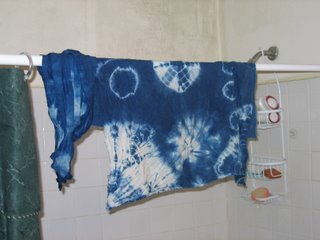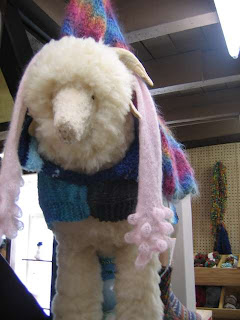Dyeing and transfiguration
Having not gotten my act together in time for Memorial Day indigo dyeing, I decided the next big patriotic holiday would have to be the one.
On the Fourth of July, we invited a small handful of friends over, (it seems like we can either invite two people or 18 people for dinner. The fact we limited this to six is sort of a miracle) and rather than crash and burn in a bucket of bad indigo in front of a whole bunch of people, (and thereby be embarassed and blue) I decided to make my first foray into indigo a smaller one. The guys cooked (burgers, corn on the cob, plus homemade French potato salad and an apple pie from Mary Lee).
 The women dyed.
The women dyed.
While we messed with string and tie-dye stuff, they also played old-time music. (Just to make it clear that it wasn't one of those parties where the guys played music and the women sat around tying string in little bunches, some of us would have played old-time music too and Aradia probably would have clogged ... but we were busy.)

I followed the directions outlined in the booklet on natural dyeing by Michele Wipplinger, of Earthues, whose dye kit I bought at Wisconsin Sheep and Wool last year. I also did a little more research on my own.
There I found that everyone seems to have their own opinions on how to use indigo properly. So I split the difference and headed down the middle.
I mixed the finely powdered indigo with water to create a paste, but not before I forgot to turn the kitchen ceiling fan off. Michele Wipplinger's powdered indigo is ground very finely indeed. Wiping it up with a damp cloth is a stupid idea.
Then I added some lye to "dissolve the indigo," as someone else wrote.
Next time, I am getting a secondhand indigo whisk at Goodwill.
I added water to my old Mason jar of blue stuff, then a few tablespoons of sodium hydrosulfite, per the directions, which said the entire thing would heat up and turn green in about 15 minutes.
We ate dinner.
This is what it looked like. That top layer is not as green as it appears in this photo. It was actually more blue than that.
 We all consulted the various books. None of them described what to do in a case like this.
We all consulted the various books. None of them described what to do in a case like this.
I decided to throw caution to the winds.
I diluted a cup of my indigo sludge with three cups of water in an old bucket. I waited for it to turn pale green. Now, I could have tested the pH with some pH strips that I happen to have but I decided not to.
First off, plenty of unlettered peasants dyed plenty of things blue back in the day without pH strips.
Second, if it turned out that the pH was wrong, I'd have to do something to fix it, and at this point, I was going on faith anyway and didn't really understand the chemistry enough to know what to do to "fix" things anyway.
So I added a little more sodium hydrosulfite until the vat turned a pale green. Said a couple Hail Marys and we tossed our yarn, roving and fabric in.

And look!
It's blue!
 Next time, I think I might have a few more people over, now that I know how this is supposed to work. I also think I might do a little more reading and try to get my head around the chemistry of it so I don't feel so much like I'm getting all Hogwarts on my back porch.
Next time, I think I might have a few more people over, now that I know how this is supposed to work. I also think I might do a little more reading and try to get my head around the chemistry of it so I don't feel so much like I'm getting all Hogwarts on my back porch.

Ask the Fool about this last picture. Am I prompting him to post? Damn skippy.

On the Fourth of July, we invited a small handful of friends over, (it seems like we can either invite two people or 18 people for dinner. The fact we limited this to six is sort of a miracle) and rather than crash and burn in a bucket of bad indigo in front of a whole bunch of people, (and thereby be embarassed and blue) I decided to make my first foray into indigo a smaller one. The guys cooked (burgers, corn on the cob, plus homemade French potato salad and an apple pie from Mary Lee).
 The women dyed.
The women dyed.While we messed with string and tie-dye stuff, they also played old-time music. (Just to make it clear that it wasn't one of those parties where the guys played music and the women sat around tying string in little bunches, some of us would have played old-time music too and Aradia probably would have clogged ... but we were busy.)

I followed the directions outlined in the booklet on natural dyeing by Michele Wipplinger, of Earthues, whose dye kit I bought at Wisconsin Sheep and Wool last year. I also did a little more research on my own.
There I found that everyone seems to have their own opinions on how to use indigo properly. So I split the difference and headed down the middle.
I mixed the finely powdered indigo with water to create a paste, but not before I forgot to turn the kitchen ceiling fan off. Michele Wipplinger's powdered indigo is ground very finely indeed. Wiping it up with a damp cloth is a stupid idea.
Then I added some lye to "dissolve the indigo," as someone else wrote.
Next time, I am getting a secondhand indigo whisk at Goodwill.
I added water to my old Mason jar of blue stuff, then a few tablespoons of sodium hydrosulfite, per the directions, which said the entire thing would heat up and turn green in about 15 minutes.
We ate dinner.
This is what it looked like. That top layer is not as green as it appears in this photo. It was actually more blue than that.
 We all consulted the various books. None of them described what to do in a case like this.
We all consulted the various books. None of them described what to do in a case like this.I decided to throw caution to the winds.
I diluted a cup of my indigo sludge with three cups of water in an old bucket. I waited for it to turn pale green. Now, I could have tested the pH with some pH strips that I happen to have but I decided not to.
First off, plenty of unlettered peasants dyed plenty of things blue back in the day without pH strips.
Second, if it turned out that the pH was wrong, I'd have to do something to fix it, and at this point, I was going on faith anyway and didn't really understand the chemistry enough to know what to do to "fix" things anyway.
So I added a little more sodium hydrosulfite until the vat turned a pale green. Said a couple Hail Marys and we tossed our yarn, roving and fabric in.

And look!
It's blue!
 Next time, I think I might have a few more people over, now that I know how this is supposed to work. I also think I might do a little more reading and try to get my head around the chemistry of it so I don't feel so much like I'm getting all Hogwarts on my back porch.
Next time, I think I might have a few more people over, now that I know how this is supposed to work. I also think I might do a little more reading and try to get my head around the chemistry of it so I don't feel so much like I'm getting all Hogwarts on my back porch.
Ask the Fool about this last picture. Am I prompting him to post? Damn skippy.


Comments